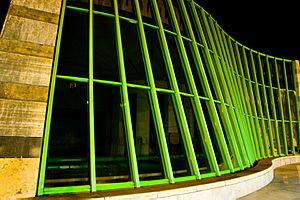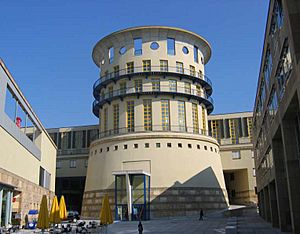James Stirling (architect) facts for kids
Quick facts for kids
James Frazer Stirling
|
|
|---|---|
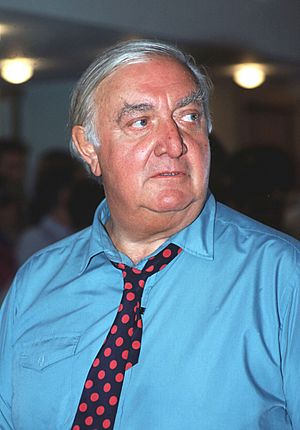
Stirling in 1991
|
|
| Born | 22 April 1926 |
| Died | 25 June 1992 (aged 66) |
| Occupation | Architect |
| Awards | Alvar Aalto Medal, 1977 RIBA Royal Gold Medal, 1980 Pritzker Prize, 1981 Praemium Imperiale, 1990 |
| Buildings | Andrew Melville Hall, St Andrews, 1960 Engineering Building, Leicester, 1963 History Faculty Library, Cambridge, UK, 1967 Neue Staatsgalerie, Stuttgart, 1983 Clore Gallery, London, 1987 No 1 Poultry, London, 1997 (posthumous completion by firm) |
Sir James Frazer Stirling (born April 22, 1926, died June 25, 1992) was a famous British architect. He designed many important buildings around the world.
Stirling often worked with other architects. He partnered with James Gowan from 1956 to 1963. Later, he worked with Michael Wilford from 1971 until his death in 1992.
Contents
Early Life and Education
James Stirling was born in Glasgow, Scotland. When he was a baby, his family moved to Liverpool, England. There, he went to Quarry Bank High School.
During World War II, Stirling joined the army. He was part of the Black Watch and later the Parachute Regiment. He was injured twice while serving.
After the war, Stirling studied architecture. He attended the University of Liverpool from 1945 to 1950. A key teacher there was Colin Rowe.
Before starting his own business, Stirling worked for several architecture firms in London. From 1952 to 1956, he worked at Lyons, Israel, Ellis. This is where he met James Gowan, who would become his first partner. This firm was known for designing buildings for public use.
Designing Modern Buildings
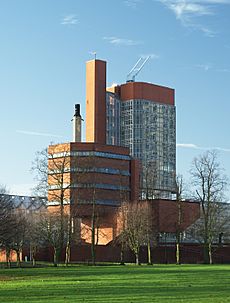
In 1956, James Stirling and James Gowan started their own company. Their first project was a small apartment building called Langham House Close (1955–58). This building was seen as an important example of 'brutalist' architecture. However, both architects did not like this label.
Another famous building they designed together is the Department of Engineering at the University of Leicester (1959–63). This building is known for its unique look and use of technology. Stirling used special 3D drawings to plan it. This project made Stirling famous around the world.
Working on His Own
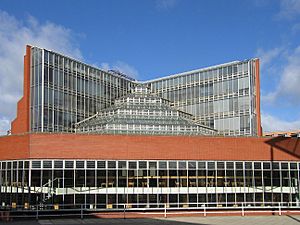
In 1963, Stirling and Gowan decided to work separately. Stirling then started his own practice. He brought Michael Wilford with him, who later became his partner.
Stirling then worked on two important university projects. These were the History Faculty Library at the University of Cambridge and the Florey Building at The Queen's College, Oxford. He also designed a training center for Olivetti and housing for the University of St Andrews. For these projects, he often used parts made in factories, like pre-cast concrete panels.
Changing Styles and Big Projects
In the 1970s, Stirling's style began to change. His projects became much larger. His designs started to look more like classical buildings, but still had a modern feel.
He designed several large museums, including three in Germany. The Neue Staatsgalerie in Stuttgart was one of his most important works. Many people called it a postmodern building, but Stirling did not agree with this label.
Stirling and Wilford's company also worked on projects in the United States. They designed buildings for several universities, including Rice University, Harvard University, Cornell University, and the University of California, Irvine.
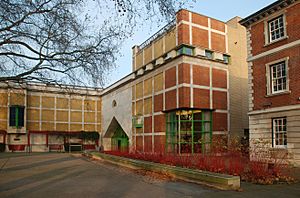
In 1981, Stirling won the Pritzker Prize. This is one of the highest awards an architect can receive.
He also received important jobs in England. These included the Clore Gallery for the Turner Collection at the Tate Britain in London (1980–87). He also designed the Tate Liverpool (1984), though it has been changed a lot since then. His last major project was No 1 Poultry in London (1986), which was finished after he passed away.
In June 1992, James Stirling was given a knighthood. This meant he could be called "Sir James Stirling." He accepted the award, hoping it would help his architecture firm.
Personal Life
In 1966, James Stirling married Mary Shand, a designer. They had one son and two daughters.
Death and Legacy
Just a few days after being knighted, James Stirling became ill. He died on June 25, 1992, after surgery. His ashes were buried near a memorial in London. After his death, his partner Michael Wilford continued their architecture practice.
The Stirling Prize, a major award for architecture in Britain, is named after him. It has been given out every year since 1996.
Many architects admire Stirling's work. He was known as a brave designer who liked to try new things. Some people thought his buildings were very strong and unique. Others felt that while his designs were interesting, they sometimes had problems.
Notable Projects
- 1958 London: Langham House Close – flats at Ham Common (with James Gowan)
- 1959 Leicester University: Faculty of Engineering (with James Gowan)
- 1961 London: Camberwell School Assembly Hall
- 1964 St Andrews University: Andrew Melville Hall of Residence
- 1968 Cambridge University: Faculty of History
- 1971 Oxford University: The Queen's College, Florey Building
- 1972 Haslemere, Surrey: Training Centre for Olivetti (extension)
- 1976 Runcorn: Southgate social housing (this building was later taken down)
- 1984 Stuttgart: Neue Staatsgalerie
- 1984 Cambridge Massachusetts: Harvard University, Fogg Museum Sackler Galleries (extension)
- 1987 Berlin: Wissenschaftszentrum (Social Science Research campus)
- 1987 London: Tate Britain, Clore Galleries (extension)
- 1989 Paris: Bibliothèque de France (a design for a competition that was not chosen)
- 1997 London: offices and shops at No 1 Poultry, London EC3 (finished after his death)
Images for kids
See also
 In Spanish: James Stirling (arquitecto) para niños
In Spanish: James Stirling (arquitecto) para niños


